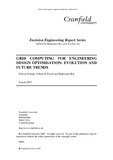JavaScript is disabled for your browser. Some features of this site may not work without it.
| dc.contributor.author | Goteng, Gokop | - |
| dc.contributor.author | Tiwari, Ashutosh | - |
| dc.contributor.author | Roy, Rajkumar | - |
| dc.contributor.editor | Editor | - |
| dc.date.accessioned | 2011-10-11T08:02:28Z | |
| dc.date.available | 2011-10-11T08:02:28Z | |
| dc.date.issued | 2007-03-01T00:00:00Z | - |
| dc.identifier.citation | Gokop Goteng, Ashutosh Tiwari and Rajkumar Roy, Grid computing for engineering design optimisation: Evolution and future trends, Decision Engineering Report Series, March 2007, Cranfield University. | - |
| dc.identifier.uri | http://dspace.lib.cranfield.ac.uk/handle/1826/4326 | |
| dc.description.abstract | Grid Computing is fast gaining ground both within academia and the commercial sectors. It has shifted from its traditional scientific-based applications to serviceoriented problem solving environments for commerce and business. Engineering design optimisation (EDO) is characteristically computationally and data intensive. EDO is also a multidisciplinary field which requires the collaboration of different domain experts to work on a design to yield improved versions. Grid Computing offers a suitable platform for design engineers to collaboratively work together and share knowledge and expertise in addition to the computational and data facility that can be combined to bear on complex designs. In this paper, the trend of Grid Computing evolution shows a clear emergence of application areas, starting from computational grid, data grid, visualisation grid and semantic grid to service-oriented problem solving environments (SO-PSE). This evolution is classified as first, second and third generation of Grid Computing for the purpose of understanding how researchers have tried to provide solutions to the problems and challenges in implementing Grid applications. The future of Grid Computing research areas such as autonomic computing, ubiquitous computing and economic Grid models as well as concurrent engineering design problem solving environments feature in the report. Autonomic computing enables grid services and resources to have self-management, self adjustable and adaptability to changing and dynamic situations using agent-based technology while ubiquitous computing allows computers to perceive the environment and act accordingly. | en_UK |
| dc.subject | Engineering design optimisation | en_UK |
| dc.subject | Grid computing | en_UK |
| dc.subject | Problem solving environments | en_UK |
| dc.subject | Service-oriented architecture | en_UK |
| dc.title | Grid computing for engineering design optimisation: Evolution and future trends | en_UK |
| dc.type | Report | - |
